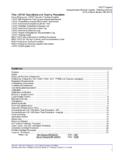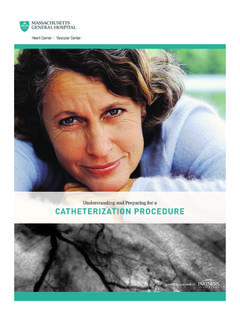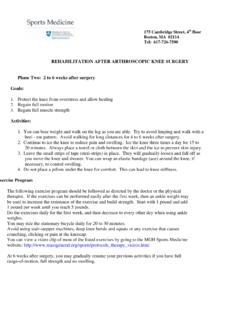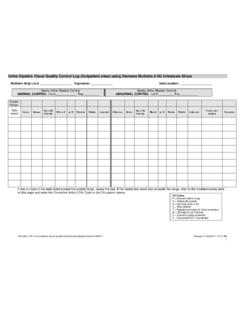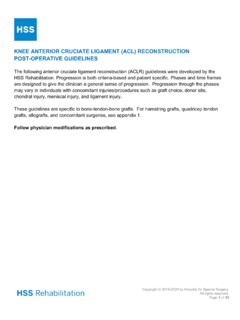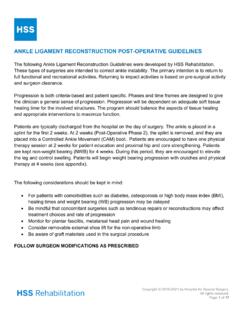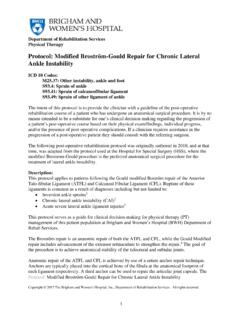Transcription of Rehabilitation Protocol for Anterior Cruciate Ligament (ACL) …
1 Massachusetts General Brigham Sports Medicine Rehabilitation Protocol for Anterior Cruciate Ligament (ACL) reconstruction This Protocol is intended to guide clinicians through the post - operative course for ACL reconstruction . This Protocol is time based (dependent on tissue healing) as well as criterion based. Specific intervention should be based on the needs of the individual and should consider exam findings and clinical decision making. The timeframes for expected outcomes contained within this guideline may vary based on surgeon s preference, additional procedures performed, and/or complications.
2 If a clinician requires assistance in the progression of a post - operative patient, they should consult with the referring surgeon. The interventions included within this Protocol are not intended to be an inclusive list of exercises. Therapeutic interventions should be included and modified based on the progress of the patient and under the discretion of the clinician. Considerations for allograft and hamstring autograft Early weight bearing and early Rehabilitation intervention vary for allograft and hamstring autograft. Please reference specific instructions below. Expectations are the early return to sport phase will be delayed.
3 Considerations with concomitant injuries Be sure to follow the more conservative Protocol with regards to range of motion, weight bearing, and rehab progression when there are concomitant injuries ( meniscus repair). post - operative considerations If you develop a fever, intense calf pain, excessive drainage from the incision, uncontrolled pain or any other symptoms you have concerns about you should call your doctor. P HA SE I: IMMED IA TE P OST-OP (0-2 W EEKS A F TER SURG ERY ) Rehabilitation Goals Protect graft Reduce swelling, minimize pain Restore patellar mobility Restore full extension, gradually improve flexion Minimize arthrogenic muscle inhibition, re-establish quad control, regain full active extension Patient education o Keep your knee straight and elevated when sitting or laying down.
4 Do not rest with a towel placed under the knee o Do not actively kick your knee out straight; support your surgical side when performing transfers ( sitting to laying down) o Do not pivot on your surgical side Weight Bearing Walking Initially brace locked, crutches (per MD recommendation) May start walking without crutches as long as there is no increased pain, effusion, and proper gait o Allograft and hamstring autograft continue partial weight bearing with crutches for 6 weeks unless otherwise instructed by MD May unlock brace once able to perform straight leg raise without lag May discontinue use of brace after 6 wks per MD and once adequate quad control is achieved When climbing stairs, lead with the non-surgical side when going up the stairs.
5 And lead with the crutches and surgical side when going down the stairs Mas s a ch u s etts G en era l Br ig h am S p o rts Me d icin e 2 Interventions Swelling Management Ice, compression, elevation (check with MD re: cold therapy) Retrograde massage Ankle pumps Range of motion/Mobility Patellar mobilizations: superior/inferior and medial/lateral o **Patellar mobilizations are heavily emphasized in the early post - operative phase following patella tendon autograft** Seated assisted knee flexion extension and heel slides with towel Low intensity, long duration extension stretches.
6 Prone hang, heel prop Standing gastroc stretch and soleus stretch Supine active hamstring stretch and supine passive hamstring stretch Strengthening Calf raises Quad sets NMES high intensity (2500 Hz, 75 bursts) supine knee extended 10 sec/50 sec, 10 contractions, 2x/wk during sessions use of clinical stimulator during session, consider home units distributed immediate post op Straight leg raise o **Do not perform straight leg raise if you have a knee extension lag Hip abduction Multi-angle isometrics 90 and 60 deg knee extension Criteria to Progress Knee extension ROM 0 deg Quad contraction with superior patella glide and full active extension Able to perform straight leg raise without lag P HA SE II.
7 IN TERMED IA TE P OST-OP (3-5 WEEKS A F TER SURG ERY ) Rehabilitation Goals Continue to protect graft Maintain full extension, restore full flexion (contra lateral side) Normalize gait Additional Interventions *Continue with Phase I interventions Range of motion/Mobility Stationary bicycle Gentle stretching all muscle groups: prone quad stretch, standing quad stretch, kneeling hip flexor stretch Strengthening Standing hamstring curls Step ups and step ups with march Partial squat exercise Ball squats, wall slides, mini squats from 0-60 deg Lumbopelvic strengthening.
8 Bridge & unilateral bridge, sidelying hip external rotation-clamshell, bridges on physioball, bridge on physioball with roll-in, bridge on physioball alternating, hip hike Balance/proprioception Single leg standing balance (knee slightly flexed) static progressed to dynamic and level progressed to unsteady surface Lateral step-overs Joint position re-training Criteria to Progress No swelling (Modified Stroke Test) Flexion ROM within 10 deg contra lateral side Extension ROM equal to contra lateral side Mas s a ch u s etts G en era l Br ig h am S p o rts Me d icin e 3 P HA SE III.
9 L ATE P OST-OP (6-8 W EEKS A F TER SURG ERY ) Rehabilitation Goals Continue to protect graft site Maintain full ROM Safely progress strengthening Promote proper movement patterns Avoid post exercise pain/swelling Avoid activities that produce pain at graft donor site Additional Interventions *Continue with Phase I-II Interventions Range of motion/Mobility Rotational tibial mobilizations if limited ROM Cardio 8 weeks: Elliptical, stair climber, flutter kick swimming, pool jogging Strengthening Gym equipment: leg press machine, seated hamstring curl machine and hamstring curl machine, hip abductor and adductor machine, hip extension machine, roman chair, seated calf machine o Hamstring autograft can begin resisted hamstring strengthening at 12 weeks Progress intensity (strength) and duration (endurance) of exercises **The following exercises to focus on proper control with emphasis on good proximal stability Squat to chair Lateral lunges Romanian deadlift Single leg progression: partial weight bearing single leg press, slide board lunges.
10 Retro and lateral, step ups and step ups with march, lateral step-ups, step downs, single leg squats, single leg wall slides Knee Exercises for additional exercises and descriptions Seated Leg Extension (avoid Anterior knee pain): 90-45 degrees with resistance Balance/proprioception Progress single limb balance including perturbation training Criteria to Progress No effusion/swelling/pain after exercise Normal gait ROM equal to contra lateral side Symmetrical Joint position sense (<5-degree margin of error) P HA SE IV : TRA N SITION A L (9-12 W EEKS A FTER SURG ERY )



